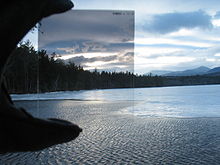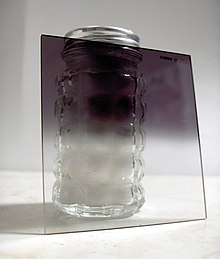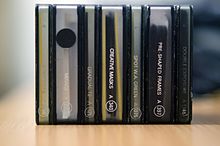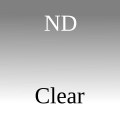134:
173:
161:
76:
25:
122:
17:
152:
A hard edge is used when there is an abrupt change in brightness, such as a field with a horizon to a bright sky. A soft edge is a wider, smoother change from light to dark. This is used when the light and dark portions are not distinctly separated, such as a mountain and sky. A soft edge filter is
60:
of film or sensor. For example, it can be used to darken a bright sky so that both the sky and subject can be properly exposed. ND filters can come in a variety of shapes and sizes and densities and can be used in all types of photographic applications from still photography, motion photography and
201:
apart and blending them with a graduated mask in an image editor. This method has the advantage that the shape of the mask can be freely defined in editing. The disadvantage is that it only works with static subjects using a tripod.
153:
less noticeable than a hard edge. It also has the benefit of making the sky more intense, darkening the sky the closer on the top. Below is a picture of what a hard edge and soft edge filter would look like.
196:
However, as long as a sufficiently short exposure time is available, it is possible to exactly mimic the effect of a graduated neutral density filter by using two exposures of the same scene one or several
83:
Graduated filters were used in the early twentieth century, for example for darkening skies in landscape photos. One advertised brand was called the "Lifa graduated filters for sky, cloud, and
67:
are ND graduated filters that are slightly opaque in the center and are clear at edges. These are used for special effects or to compensate for light falloff that is natural with large optics.
79:
The same image with a GND-like effect applied to the right side of the image using a computer. While the overall effect is similar, regions of the image that were washed out are not recovered.
113:("blown out" or "washed out") captures no usable data in the clipped area, an effect which cannot be corrected with later processing because data has been lost.
28:
The same image with washed-out (white) pixels colored red. Note that clouds that are washed out without the GND filter show detail behind the filter.
56:
which transitions, either abruptly or gradually, into the other half which is clear. It is used to bring an overly-bright part of a scene into the
193:(HDR) which allow the camera to capture and then combine different exposures of the same subject matter when shooting in RAW image format.
241:
298:
280:
264:
360:
327:
20:
A GND filter held up to the horizon. Note the poor contrast in the overexposed part of the sky not covered by the filter.
218:
317:
190:
92:
109:, graduated ND filters are still an important tool for professionals because a digital sensor that is
91:
photography, and sometimes used a yellow top half to darken blue skies more. In a discussion at the
352:
401:
102:. Singh-Ray sold them as "The Singh-Ray set of 4 Galen Rowell Graduated Neutral-Density Filters."
189:
As an alternative to split graduated neutral density filters, some digital cameras offer built-in
172:
160:
110:
53:
95:
in 1910, some "debatants" held the use of such "graduated color screens" to be quite limited.
84:
345:
8:
356:
323:
381:
347:
Understanding
Exposure: How to Shoot Great Photographs with a Film Or Digital Camera
106:
88:
386:
133:
198:
141:
The filter comes in many types but can be separated into two basic categories:
87:". These "sky filters" were not necessarily neutral, since they were used for
49:
395:
57:
99:
52:
that has a variable light transmission. Typically half of the filter is of
98:
In more modern times, the use of graduated ND filters was popularized by
75:
105:
Although its importance may have lessened with the advent of the modern
24:
315:
121:
126:
16:
269:. Vol. 14. American Photographic Publishing Co.
344:
184:
342:
393:
367:hard soft edge graduated neutral density filter.
262:
316:Katrin Eismann; Sean Duggan; Tim Grey (2003).
287:. American Photographic Pub. Co.: 358 1920.
252:. Photographic Times Publishing Assn.: 113.
239:
229:(4). Hearst Magazines: 116–117. April 1981.
303:The Professional and Amateur Photographer
219:"These New Filters Create Amazing Photos"
132:
120:
74:
23:
15:
394:
13:
382:An effective demonstration picture
14:
413:
375:
129:3-stop (ND8) graduated ND filter.
171:
159:
34:graduated neutral-density filter
387:Image Tools Filter - Brightness
185:Multi-shoots high dynamic range
137:Stacked cases of Cokin filters.
336:
319:Real World Digital Photography
309:
291:
273:
256:
233:
211:
1:
205:
155:
299:"British Photographic Notes"
42:split neutral-density filter
7:
266:Practical Color Photography
10:
418:
343:Bryan F. Peterson (2004).
191:high-dynamic-range imaging
93:Royal Photographic Society
70:
351:. Amphoto Books. p.
263:Edward John Wall (1922).
61:scientific applications.
116:
246:The Photographic Times
242:"The Prismatic Filter"
138:
130:
80:
29:
21:
285:American Photographer
136:
124:
85:landscape photography
78:
27:
19:
305:: 264. May 25, 1910.
240:L. R. Gwyer (1908).
178:Hard-edge GND filter
166:Soft-edge GND filter
65:Center-spot filters
38:graduated ND filter
322:. Peachpit Press.
139:
131:
81:
36:, also known as a
30:
22:
362:978-0-8174-6300-7
329:978-0-321-22372-2
223:Popular Mechanics
409:
370:
369:
350:
340:
334:
333:
313:
307:
306:
295:
289:
288:
277:
271:
270:
260:
254:
253:
237:
231:
230:
215:
175:
163:
107:digital darkroom
46:graduated filter
417:
416:
412:
411:
410:
408:
407:
406:
402:Optical filters
392:
391:
378:
373:
363:
341:
337:
330:
314:
310:
297:
296:
292:
281:"Changing Bait"
279:
278:
274:
261:
257:
238:
234:
217:
216:
212:
208:
187:
182:
179:
176:
167:
164:
119:
89:black-and-white
73:
54:neutral density
12:
11:
5:
415:
405:
404:
390:
389:
384:
377:
376:External links
374:
372:
371:
361:
335:
328:
308:
290:
272:
255:
232:
209:
207:
204:
186:
183:
181:
180:
177:
170:
168:
165:
158:
150:
149:
146:
118:
115:
72:
69:
50:optical filter
9:
6:
4:
3:
2:
414:
403:
400:
399:
397:
388:
385:
383:
380:
379:
368:
364:
358:
354:
349:
348:
339:
331:
325:
321:
320:
312:
304:
300:
294:
286:
282:
276:
268:
267:
259:
251:
247:
243:
236:
228:
224:
220:
214:
210:
203:
200:
194:
192:
174:
169:
162:
157:
156:
154:
147:
144:
143:
142:
135:
128:
123:
114:
112:
108:
103:
101:
96:
94:
90:
86:
77:
68:
66:
62:
59:
58:dynamic range
55:
51:
47:
43:
39:
35:
26:
18:
366:
346:
338:
318:
311:
302:
293:
284:
275:
265:
258:
249:
245:
235:
226:
222:
213:
195:
188:
151:
140:
104:
100:Galen Rowell
97:
82:
64:
63:
45:
44:, or just a
41:
37:
33:
31:
206:References
148:Soft edge
145:Hard edge
396:Category
111:clipping
48:, is an
71:History
359:
326:
199:stops
127:Cokin
117:Types
357:ISBN
324:ISBN
353:150
227:155
398::
365:.
355:.
301:.
283:.
250:40
248:.
244:.
225:.
221:.
125:A
40:,
32:A
332:.
Text is available under the Creative Commons Attribution-ShareAlike License. Additional terms may apply.






